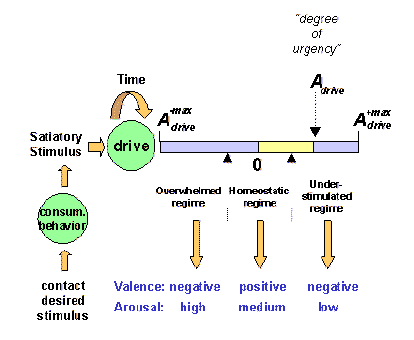

|
In general, animals are in constant battle with many different sources of danger. They must make sure that they get enough to eat, that they do not become dehydrated, that they do not overheat or freeze, that they do not fall victim to a predator, and so forth. The animal's behavior is beautifully adapted to survive and reproduce in this hostile environment. Early ethologists used the term motivation to broadly refer to the apparent self-direction of an animal's attention and behavior.
Homeostatic regulationTo survive, animals must maintain certain critical parameters within a bounded range. For instance, an animal must regulate its temperature, energy level, amount of fluids, etc. Maintaining each critical parameter requires that the animal come into contact with the corresponding satiatory stimulus (shelter, food, water, etc.) at the right time. The process by which these critical parameters are maintained is generally referred to as homeostatic regulation.In a simplified view, each satiatory stimulus can be thought of as an innately specified need. In broad terms, there is a desired fixed point of operation for each parameter, and an allowable bounds of operation around that point (see figure). As the critical parameter moves away from the desired point of operation, the animal becomes more strongly motivated to behave in ways that will restore that parameter. The physiological mechanisms that serve to regulate these needs, driving the animal into contact with the needed stimulus at the appropriate time, are quite complex and distinct.

The drives influence the emotion processes. In this manner, the robot's ability to satisfy its drives and remain in a state of "well being" is reflected by its affective state. When in the homeostatic regime, a drive contributes to those processes characterized by positive valence and balanced arousal. This corresponds to a "contented" affective state. When in the under-stimulated regime, a drive spreads activation to those processes characterized by negative valence and low arousal. This corresponds to a "bored" affective state that can eventually build to "sorrow". When in the overwhelmed regime, a drive spreads activation to those processes characterized by negative valence and high arousal. This corresponds to an affective state of "distress". The emotion system influences the robot's facial expression. The caregiver can read the robot's facial expression to interpret whether the robot is "distressed" or "content", and can adjust his/her interactions with the robot accordingly. The caregiver accomplishes this by adjusting either the type (social verses non-social) and/or the quality (low intensity, moderate intensity, or high intensity) of the stimulus presented to Kismet. These emotive cues are critical for helping the human work with the robot to establish and maintain a suitable interaction where the robot's drives are satisfied, where it is sufficiently challenged, yet where it is largely competent in the exchange.
|
|||||||||||||||||||||||||||||||||||||||||||